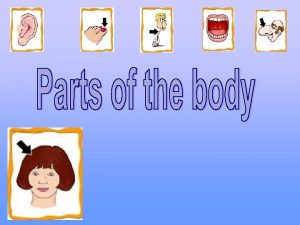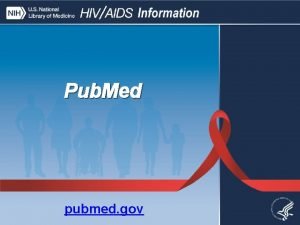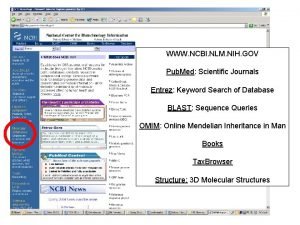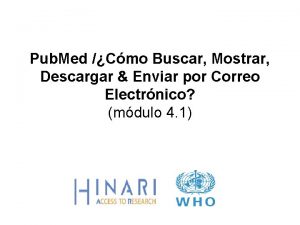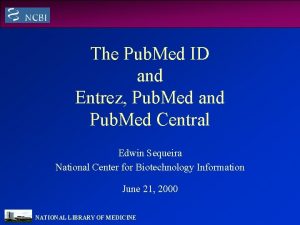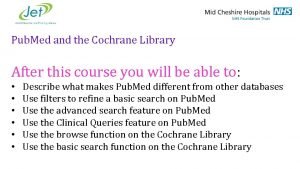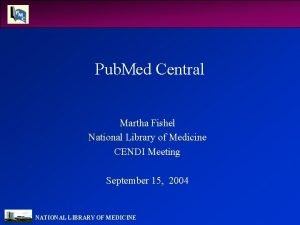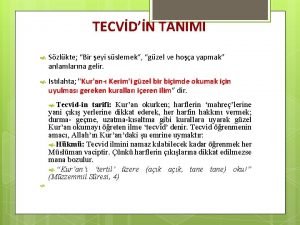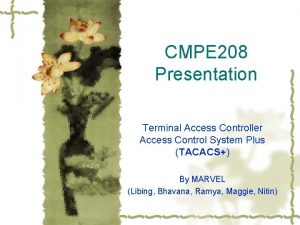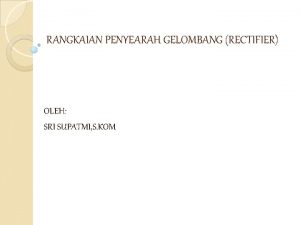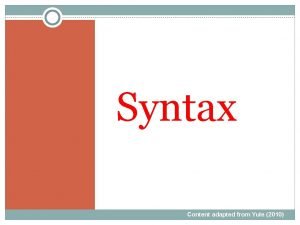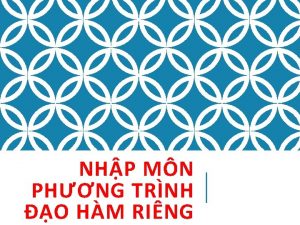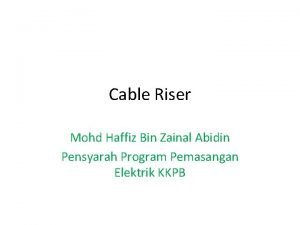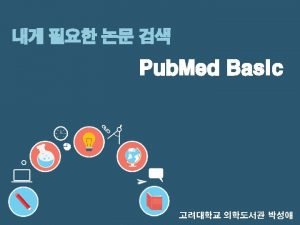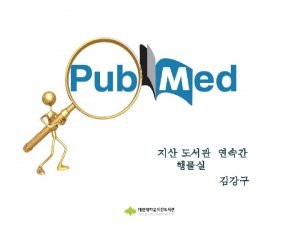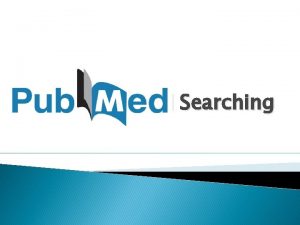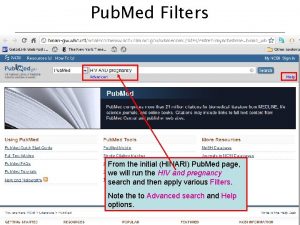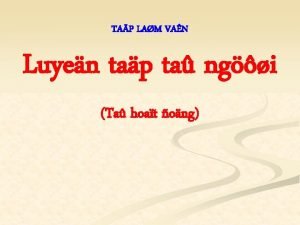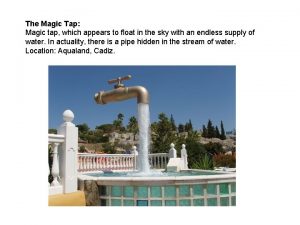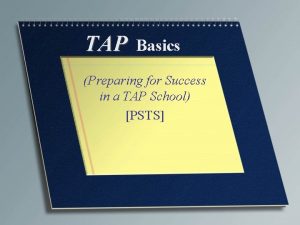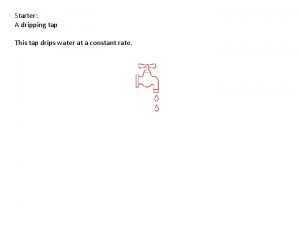Pub Med on Tap Access Pub Med on

Pub. Med on Tap: Access Pub. Med on Handheld, Wireless Devices Dina Demner-Fushman University of Maryland, College Park and CEB/LHNCBC/NLM/NIH/HHS

Pub. Med on Tap • a pilot R&D project of the Communications Engineering Branch, Lister Hill National Center for Biomedical Communications, National Library of Medicine, National Institutes of Health, Health and Human Services • Goal – Develop a stable system to study design principles for delivery of medical information to handheld devices at the point-of-care • Designers/Developers – Susan Hauser, project leader – Glenn Ford – Dina Demner-Fushman

Outline • • • Motivation Pub. Med at a glance Design questions Usability study Next steps

Why patients need just-in-time information for clinicians: Patient Fact Sheet 20 Tips to Help Prevent Medical Errors …. Medical errors are one of the Nation's leading causes of death and injury. A recent report by the Institute of Medicine estimates that as many as 44, 000 to 98, 000 people die in U. S. hospitals each year as the result of medical errors. This means that more people die from medical errors than from motor vehicle accidents, breast cancer, or AIDS…. . Ask your doctor if your treatment is based on the latest evidence AHRQ Publication No. 00 -PO 38, February 2000. Agency for Healthcare Research and Quality http: //www. ahrq. gov/consumer/20 tips. htm motivation Pub. Med design usability future

Doctors are encouraged to search for evidence based answers to their questions about patient care but most go unanswered Fifty nine obstacles were found while attempting to answer clinical questions with evidence 3. Obstacles related to seeking information 3. 1. 3. Lack of time to initiate search 3. 2. 1. Uncertainty about where to look for information 3. 3. 1. Resource physically distant 3. 3. 9. Resource not current 3. 3. 10. …. Most general resources do not allow real time interaction with the searcher (Ely et al. , British Medical Journal. 2002) motivation Pub. Med design usability future

Where to look for information motivation Pub. Med design usability future

Current interactive resource at hand • Speed up search – Navigation – Presentation • Provide expected Pub. Med functionality motivation Pub. Med design usability future

Pub. Med Search motivation Pub. Med design usability future
![Advanced Search ("variola virus"[Me. SH Terms] OR "smallpox"[Me. SH Terms]) AND hasabstract[text] AND Clinical Advanced Search ("variola virus"[Me. SH Terms] OR "smallpox"[Me. SH Terms]) AND hasabstract[text] AND Clinical](http://slidetodoc.com/presentation_image/6927358efb76734e87f0e767d0a840ea/image-9.jpg)
Advanced Search ("variola virus"[Me. SH Terms] OR "smallpox"[Me. SH Terms]) AND hasabstract[text] AND Clinical Trial[ptyp] AND jsubsetaim[text] AND "adult"[Me. SH Terms] AND ("hominidae"[Me. SH Terms] OR "Human"[Me. SH Terms]) AND ("2000"[PDAT] : "2004"[PDAT]) motivation Pub. Med design usability future

Clinical Queries motivation Pub. Med design usability future

Search Results motivation Pub. Med design usability future

Working with Search Results Navigating results pages motivation Pub. Med design usability future

Working with Search Results Viewing selected citations and links motivation Pub. Med design usability future

Working with Search Results Saving selected citations motivation Pub. Med design usability future

Saving Search Strategy Use the Cubby to store search strategies and Link. Out preferences. Access Cubby on the Pub. Med sidebar. You need to register for the Cubby and then login whenever you want to use it. Your web browser must be set to accept cookies. motivation Pub. Med design usability future

Interface Design Challenges • Maximize utilization of 160 x 160 pixels, but don’t lose readability • Decide what information is essential for an overview and how to organize ‘detail on demand’ • Organize content in an easy to navigate manner, avoid scrolling • Find clear graphical metaphors for task objects and actions • Maximally approximate users’ model of the existing desktop application motivation Pub. Med design usability future

Our Approach • Identify most likely target user’s tasks • Develop a working prototype, and present to potential users for feedback • Develop a stable system with a usable interface and sufficient features to be useful • Conduct usability study • Release the improved system to health care professionals, listen to users’ feedback, and study aggregate user statistics motivation Pub. Med design usability future

Organizing Content prototype presentation u s a b i l i t y s t u d y motivation Pub. Med design usability future

Organizing Content continued motivation Pub. Med design usability future

Finding Metaphors is Hard motivation Pub. Med design usability future

Maintaining common feel and look for different platforms and operating systems is hard motivation Pub. Med design usability future

Usability Study • Conducted at the National Cancer Institute (NCI) usability laboratory, facilitator Gregory Alexander, RN • 9 subjects (informatics students, nurses, physicians, and medical librarians) • 3 test tasks embedded in clinical scenarios • 6 observers taking “stream of consciousness” notes, while viewing participant’s face and the PDA projected on a large screen • Post-test questionnaire motivation Pub. Med design usability future

Usability Study Results All participants were able to find Medline citations containing answers to questions described in all test scenarios There is strong correlation between time to completion and problems in locating functions and navigation motivation Pub. Med design usability future

Usability Study Observations 234 unique observations Most frequent observations. Participants: • Found brief mode (more titles per screen) useful • Were confused by the related articles icon • Did not know how to get back to the search tab from the profiles • Did not know how to drill down to a citation • Expected more information messages, e. g. on saving profiles • Hesitated tapping the search globe motivation Pub. Med design usability future

Next Steps • Organize content using key points of clinical scenario • Conduct usability testing of all alternative layouts • Include other NLM resources, e. g. practical guidelines motivation Pub. Med design usability future

PMOT home http: //archive. nlm. nih. gov/proj/pmot. php Contact: demner@cs. umd. edu ddemner@mail. nih. gov
- Slides: 26
